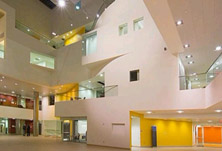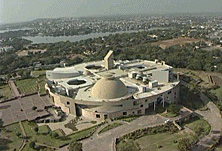
Having built prolifically in India, architect Charles Correa is less known in the west, but nevertheless has received the highest awards worldwide for his work. Born in India and trained in the United States, Correa’s architecture incorporates the philosophies of both traditions. Although often austere and modern, Correa’s work is never cold or alienating; it is based in the concerns of daily life, culture, and climate and he frequently collaborates with other artists, including his wife Monica, a textile artist. The film examines Correa’s life and work, presenting many interviews with Correa himself explaining his concepts, as well as stills, diagrams, animation and archival footage. Connections between film and architecture abound in Correa’s work, describing both as a succession of images, and generous footage of his buildings allow the viewer to experience his beautifully conceived spaces. |
|

This rich overview brings the warmth and care in Correa’s work to life, and clearly expresses his central obsessions and ideas. Designing at numerous scales, from the family house to urban planning, Correa’s continuing themes include the ritualistic pathway, the metaphysics of open air spaces, and the concept of the “non-building”. The film captures the delicate qualities of his work and opens up Correa’s humanistic thought process to generate architectural space and form. |
|
Volume Zero – The Works of Charles Correa
India 2008, 59min.
English. No subtitles
Crew
Cinematography: Sudhir Palsane, Manoj Peter, Rajendra Jangley, Ashu Solanki, Sankalp Meshram, Sudhakar Reddy, Yakkanti, Naiyer Ghufran
Sound: Anita Kushwaha, Vinod Subramaniam
Editing: Sankalp Meshram
Production: Arun Khopkar
Director
Arun Khopkar (Mumbai, 1945) has directed two feature films that have been shown at various international festivals and made non-feature films that have won several national and international awards (he won India’s national film award, the Golden Lotus, three times). He has contributed papers on film aesthetics to various national and international journals and has taught film theory and practice at various institutions such as Moscow School for Advanced Cinematography, Jawaharlal Nehru University and FTII. |